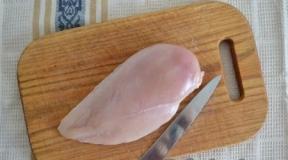The optimal number of calories per day. How many calories do you need per day to lose weight? online calorie calculator
Do you want to lose weight faster and healthier? Just calculate your own daily calorie intake and get closer to the cherished figure on the scales. You will find the formula for individual calculation of calories in the article.
Calorie calculation allows you to choose the perfect menu for a person. There are universal figures for the daily calorie intake: for women, their optimal amount is 2000 kcal, for men - 2500. The indicated figures are a calculated average, but many factors should be taken into account: lifestyle, gender, age. This article will help you calculate your ideal daily calorie requirement to lose or maintain weight.
Daily calorie calculation
Calorie content - the energy value of products released in the body in the event of successful, complete assimilation of the food consumed. The energy value of the product is measured in kilocalories (kcal) per 100g. product. What is energy value? The amount of carbohydrates, proteins and fats. In other words, activity and working capacity, health status depends on what and in what quantity we eat. appearance. When there is an excess of calories, they are transported to fat “reserves”, when there is a shortage, they are “extracted” from there. That's the whole process of losing weight.
How to calculate calories per body weight
There are various formulas developed by scientific researchers to calculate the optimal calorie content of a person's diet. Some of them are more true, others less. Calorie intake can be calculated in several ways:
Mifflin–Saint Geor formula
The calculation method, which was called the “Mifflin-Saint Geor Formula”, was discovered in 2005 and is considered the most optimal method for compiling a diet for an adult. However, the disadvantage of this method is the lack of consideration of the ratio of muscle tissue and body fat in the body, because metabolism depends on muscle mass.
The calculation of the metabolic rate should be made according to the following principle:
- for men: 10 x weight (in kg) + 6.25 x height (in cm) - 5 x age (in years) + 5;
- for women: 10 x weight (in kg) + 6.25 x height (in cm) - 5 x age (in years) - 161.
To calculate the rate of calories in the diet of an adult to maintain a stable weight, you need to take into account the level and duration physical activity. This or that type of activity is indicated by the coefficient of physical activity (CFA). The data obtained during the calculation of the metabolic rate must be multiplied by CFA. The result will be the required daily intake of kilocalories.
Physical activity coefficients (K)
- Minimum loads - K=1.2;
- some physical activity, light exercise 1-3 times a week - K = 1.375;
- sports loads 4-5 times a week (or work moderate) — K= 1.4625;
- increased intensity training 4-5 times a week - K=1.550;
- daily workouts - K=1.6375;
- daily intensive training or training 2 times a day - K=1.725;
- hard physical work plus intensive sports loads 2 times a day - K = 1.9.
A 45-year-old man weighs 74 kg. His height is 178 cm. He visits the gym four times a week. The result is an amount that is equal to 2372 kcal.
Harris-Benedict Formula
The formula was derived back in 1919, so now it is not correct enough and has an error of about 5%.
- for a man: 66.5 + 13.75 x weight (kg) + 5.003 x height (cm) - 6.775 x age (years);
- for a woman: 655.1 + 9.563 x weight (kg) + 1.85 x height (cm) - 4.676 x age (years).
The woman is 32 years old, weight - 60 kg, height - 167 cm. According to the calculations according to the formula, she needs 1666 kcal to maintain her weight.

WHO Formula
This formula is also based on CFA on the following scale:
- 1 - low;
- 1, 3 - medium;
- 1.5 - high.
The daily calorie requirement of a person is calculated as follows:
- for women 18-30 years old: (0.062 × mass in kg + 2.036) × 240 × CFA;
- 31-60 years old: (0.034 × mass in kg + 3.538) × 240 × CFA;
- over 60 years: (0.038 × weight in kg + 2.755) × 240 × CFA;
- for men aged 18-30: (0.063 × body weight in kg + 2.896) × 240 × CFA;
- 31-60 years old: (0.484 × body weight in kg + 3.653) × 240 × CFA;
- over 60 years: (0.491 × body weight in kg + 2.459) × 240 × CFA.
A 23-year-old girl weighs 53 kg, the level of activity is average. She needs 1660 kcal per day.

Ketch–McArdle formula
The use of this technique involves taking into account the amount of body fat in the body, but its drawback is the lack of consideration of age, sex and height of a person. It also reduces the accuracy of the calorie requirement calculation results.
According to the Ketch-McArdle formula, the daily calorie content is calculated as follows: basal metabolism = 370 + 21.6 × x (body weight minus fat).
According to the Ketch-McArdle formula, a 22-year-old guy weighing 70 kg should consume 2000 kcal / day.

It is important to remember that energy is also spent on consumption and metabolic processes. For the properties of some products (celery, ginger, fresh cabbage) “take away” more energy from the body than give, they are called products with a negative calorie content. And the whole process of a person's energy expenditure on the digestion of food is called the specific dynamic action of food (abbreviated SDA). The average figure for DDS is 10% of the basic metabolic rate.
Daily calorie intake for a person
Every hour we spend 1 calorie on the "maintenance" of one kilogram of body weight. Let's say your weight is 60 kg. If we multiply this figure by 24 (based on the number of hours in a day), we get 1440. However, this calculation is not correct without taking into account the level of mental and physical activity, stress, etc.
For men
For the stronger sex, the question of the norm daily ration definitely important. And it's not just about trying to keep fit. Being healthy is always fashionable. And given that the rhythm of life is sometimes “rich” in stress, modern man became more attentive to the quality and quantity of food eaten.

Tracking the calorie content of the diet is the basis of proper nutrition. The difference between women's diets and men's diets is that men have an accelerated metabolic process (metabolism). Therefore, it is easier for them to lose weight than for women. So, the diet for representatives of the strong half of humanity should not be too scarce.
So, if a man wants to maintain physical fitness at an optimal level for him, but at the same time lead a predominantly inactive lifestyle, then you should be guided by this rule:
- if a man is from 18 to 30 years old, then he can consume 2400 kcal per day;
- at the age of 31 to 50 years, the daily norm should be 2200 kcal;
- over 50 years old, 2000 kcal will be enough.
If a man’s day proceeds at a rhythm of medium intensity, then he needs:
- at the age of 18 to 30 years, 2600-2800 kcal should be consumed;
- at the age of 31 to 50 - 2400-2600 kcal;
- from 50 - 2200 - 2400 kcal per day.
- from 18 to 30 years old you need to consume 3000 kcal;
- at the age of 31 to 50 - 2800 - 3000 kcal;
- at the age of more than 50 - 2400 - 2800 kcal per day.
For women
As a rule, the female body needs fewer calories than the male. This is due to the fact that women gain weight faster - as provided by nature in order to protect the female body in order to fully procreate. You should not conflict with nature, but for any girl and woman it is very important to be in shape. In order to maintain a stable weight, they need to focus on factors such as age, activity level, living conditions and individual characteristics.

Physical activity determines the amount of calories allowed to be consumed to maintain weight. If a girl or woman leads a sedentary lifestyle, then she should learn:
- the daily norm for girls from 18 to 25 years old is about 2000;
- at the age of 26 to 50 years - 1800 kcal;
- after 50 years - 1600 kcal.
Women and girls leading a moderately active lifestyle should consume:
- at the age of 18 to 25 - without fear for the figure, you can consume 2200 kcal per day;
- from 26 to 50 - recommended 2000 kcal;
- after 50 years, the norm is 1800 kcal.
Women who lead an active lifestyle need:
- 18-30 years old - 2400 kcal;
- for 31-60 year olds is 2200;
- after 60, 2000 per day is required.
If a woman needs to calculate calories for weight loss, then 500 kcal should be subtracted from these norm indicators and make up her diet depending on the resulting amount. There is a very common belief: for effective weight loss, the caloric content of the diet should be reduced to 1200 per day. However, this is true only if a woman leads an inactive lifestyle. Because it is under this condition that weight loss will be healthy. And a sharp reduction in the calorie content of the diet, complemented by high physical activity, can provoke serious health problems: of cardio-vascular system(symptoms - dizziness, nausea, weakness), disruptions in the menstrual cycle (up to amenorrhea), slow metabolism and weakening of the immune system.
For pregnant
Women expecting babies should remember that losing weight during this period is strictly prohibited. But to abuse high-calorie foods, eating "for two" is also not worth it.

The first factor on which the caloric content of the diet of the expectant mother should depend is the gestational age. With an increase in the duration of pregnancy, calorie content should increase: starting from 2500, and up to 3200 calories per day - in the last stages. This is explained by the fact that the body of the future mother is in the process of hormonal "restructuring", which in itself is energy-consuming. In addition, it is important to feed enough energy to the baby, both during pregnancy and after birth. The daily caloric content of the diet of a nursing mother should be 3500 kcal.
For teenagers
The diet of a teenager should be carefully balanced and have sufficient calories. This is important for several reasons. Firstly, the period of puberty is accompanied by energy-consuming processes for the organisms of boys and girls. In addition, the immunity of young people during this period is subjected to significant tests, so it must be protected through proper nutrition. Secondly, teenagers should avoid all kinds of junk food and try to eat regularly, since they are the ones who are most susceptible to such a disease as gastritis.

Physical activity is also a very important factor in shaping the diet of a teenager. So, if a boy or girl goes in for sports and leads an active lifestyle, then daily calorie content their diet should be 2200 - 2500 kcal - for boys, and 1800 - 2200 - for girls. If a teenager leads an inactive lifestyle, then the daily calorie content of his food should not be more than 2000 calories, since the risk of rapid weight gain during this period increases significantly due to hormonal changes in the young body.
For kids
The calorie content of a child's diet varies depending on the age of the child. So, the calorie intake per day of feeding a child should increase every six months. This is explained by the fact that the child's body is growing, and in order for it to develop fully, it needs a large number of energy.

The number of calories your baby needs depends on their age:
- babies 1-2 years old need 1200 kcal;
- from 2 to 3 years - 1400;
- children from 3 to 6 years old should consume 1800-2000;
- a child aged 6 to 10 years needs to consume from 2000 to 2400;
- and at the age of 10-13 years, the norm of calories per day is 2900.
Of great importance is the quality of the calories absorbed by the child. Number of confectionery products, drinks with great content sugar, flour - must be limited, since these categories of products have practically no useful properties, but they can harm a growing body (gastritis, allergic diseases, overweight). A fresh fruits, vegetables, cereals, natural dairy products, meat and fish should form the main diet of the child.
The calorie content of the daily children's diet should be adjusted based on the rhythm of the child's life. If the child is very mobile, then he needs more energy. An increased need for calories will be in a child who attends various sections, circles. After the age of 13, the child's diet can be formed in accordance with the calorie content that a teenager needs, since the process of puberty begins during this period.
Carbohydrates, proteins and fats
In addition to how many calories to consume, it is important to keep track of what they are derived from. The quality of food is the main condition for the healthy functioning of the body. The human diet must be properly balanced. And balance is a reasonable ratio of proteins, fats, carbohydrates, as well as essential trace elements in the food consumed. That is, it is wrong to eat 2000 kcal with one cottage cheese, just as it is unreasonable to eat 1300 of sweets. In both cases, the body experiences deprivation and stress at the same time. The likely outcome of the first case is indigestion, heaviness in the stomach. The second is a sharp increase in blood sugar levels and the possibility of “acquiring” an allergic rash.

In order to improve the quality of the diet, which directly affects the state of your health, try to eliminate, or at least reduce the amount of trans fats (in large quantities found in confectionery), sugar and starchy foods.
Daily rate consumption of proteins, fats and carbohydrates
- proteins (50% - protein of animal origin): 65 - 117 g;
- fats: 70 - 154 g;
- carbohydrates: 257-586 g.
- proteins: 58-87 g;
- fats: 60-102 g;
- carbohydrates: 250 - 450 g.
It is important to include in the diet foods that contain macro (calcium) and microelements (iodine, iron) necessary for a person, as well as vitamins, amino acids and fatty acids.
There is a formula for the ratio of proteins, fats and carbohydrates in the diet: 1 (B): 1 (F): 4 (U). However, such a calculation is approximate, because the amount of substances consumed is also regulated depending on physical activity, mental activity and the properties of the body of a particular person.
Staying fit is easy!
Calorie counting is a useful practice that is forever fixed in the mind. You already know approximately the calorie content of each product and you can even offhand estimate the calorie content of the whole festive table. In addition, you get used to eating the right products and determine the moment of satiety. And when you see fast food, breathtaking numbers appear before your eyes. However, remember that scrupulous calorie counting should not be accompanied by fear and remorse for every bite eaten. Get from food not only energy, but also pleasure. And most importantly - listen carefully to the true needs of your body. He will not "advise" what will harm him.
Don't forget that:
- conduct fasting days, contrary to disagreements, is not harmful, but very useful. So, you do not have to fast once a week - just choose best option unloading. For example, a fasting day on buckwheat porridge (250 grams) and green tea (in any quantity), in which these products are recommended to be consumed in small portions and often, once every 1.5-2 hours;
- it is important to monitor the amount of crude plant food in the diet. Firstly, there is fiber in such food, and secondly, vitamins and microelements are stored in it, which are most often destroyed during heat treatment;
- you can not become an ideologue separate power supply, however, it is useful to practice it, because it forms the habit of more carefully monitoring the quality of nutrition;
- You can eat fast carbohydrates, but you should do it in the morning. And, of course, in moderation. So, you can treat yourself to a small piece of your favorite cake with your morning coffee - even if you have a day that is not very saturated with physical activity, you will use up the calories received.
calorie diets
We offer you options balanced menu one day from different caloric content. Depending on your physical activity, you can adjust it by adding or reducing calories. This way of eating is an example of how you can eat all your life while maintaining good physical shape and health.
1300 calorie per day diet
Menu
- First breakfast: two rye bread with 1 tablespoon strawberry jam, 50 g banana, tea / coffee with milk 1.5% fat;
- lunch: buckwheat porridge on water (170 g), 1 apple;
- lunch: chicken broth (200 ml), boiled fillet chicken (200 g);
- afternoon snack: cottage cheese 5% fat without sugar (150 g), tea;
- dinner: steamed hake (180 g), salad (200 g Chinese cabbage+ 100 g cucumbers + 50 g carrots + 2 tablespoons olive oil), tomato juice(100 ml).

Review
Julia, 25 years old, interior designer. Weight - 54 kg
“What kind of diets I have not experienced on myself. Now I understand that I tortured myself in vain. When I stopped living with restrictions and “reconciled” with the body, the extra weight went away by itself. 1300 kcal is not enough for me. Such food is only suitable for a person who sits at home and does nothing. And I wander around the city, so it even reached half-conscious states. After all, a scrupulous calculation of what you eat is also a kind of stress. At that time, problems arose in terms of gynecology, so I decided to quit my half-starved existence, although I lost five kilograms in two weeks - from 64 to 59. It's better to be healthy."
1800 calories
Menu
- First breakfast: fruit salad(1 apple, 1 banana, 1 kiwi + 150 ml natural yogurt+ 1 teaspoon of honey), tea / coffee without sugar;
- second breakfast: scrambled eggs (from two eggs and 100 ml of milk);
- lunch: buckwheat porridge on the water (200 g), salad dressed with olive oil (200 g white cabbage+ 100 g cucumbers + 150 g tomatoes + 2 teaspoons olive oil), baked cod (200 g);
- afternoon tea: cottage cheese casserole(200 g cottage cheese 9% fat + 1 tablespoon sour cream 15% fat + 2 tablespoons sugar), green tea;
- dinner: boiled chicken / fish (hake) (200 g), salad (200 g Chinese cabbage + 100 g cucumbers + 1 tablespoon olive oil), tomato juice (150 ml).

Review
Igor, 32 years old, system administrator. Weight change - from 82 kg to 70 kg
“At some point, I felt that sedentary work gave its“ fruits ”in the form extra pounds. I noticed that it became harder to walk, shortness of breath began to appear. I decided to count calories. At first it was hard - not so much in terms of hunger, but mentally: to be constantly on the alert, to watch every bite - I'm not used to this. But after a week of "privations" I noticed the result - minus 3 kg. Given the low physical activity, I did not experience acute hunger, although the desire to “eat what I had eaten” periodically appeared. Was pleased with the result. I learned to be more careful about what I absorb.
2000 calories
Menu
- First breakfast: tea / coffee with milk 1.5% fat (15 g), milk chocolate(40g);
- second breakfast: oatmeal with milk 2.5% fat (150 g oatmeal+ 100 ml milk) with raisins (2 teaspoons) and nuts (2 tablespoons);
- lunch: soup with meatballs (250 ml), salad (100 g Chinese cabbage + 100 g fresh cucumbers+100 g of boiled chicken fillet + 2 tablespoons of sour cream 15% fat);
- afternoon snack: casserole (100 g champignons + 100 g potatoes + 70 g chicken fillet + 30 g parmesan), biscuit (150 g), Orange fresh(150 ml);
- dinner: cottage cheese 9% fat (200 g), sweet tea(200 ml).

Doctor's review
Ekaterina Kuzmenko, gastroenterologist, Kiev
“From the point of view of medicine, such a menu is absolutely balanced. Important point is the size of the portions and the frequency of their intake. No wonder even folk wisdom says that less is better, but more often. This is true for nutrition. When we eat in small portions 4-5 times a day, the stomach does not experience excessive stress, and metabolic processes are constantly in active mode. Thus, no additional effects on metabolism are required. The result - the digestive system is in order, you are in good physical shape and stay young longer. After all, it is known that both malnutrition and overeating adversely affect the state of the body.
3000 calories
Menu
- First breakfast: sweet oatmeal with a banana (100 g of oatmeal + 150 ml of milk 1.5% fat + 50 g of banana + 2 teaspoons of sugar);
- second breakfast: croissant with jam (80 g), milk chocolate (50 g), tea / coffee;
- lunch: pasta with chicken breast (120 g pasta + 100 g chicken breast+ 3 g (1 teaspoon) parmesan), salad (200 g Chinese cabbage + 1 egg+ 2 tablespoons of sour cream 15% fat);
- snack: 1 banana or 1 apple, roasted peanuts(70 g);
- afternoon tea: milkshake(200 ml milk 2.5% fat + 70 g cream ice cream 8% fat), 50 g shortbread cookies, 40 g milk chocolate;
- dinner: baked potatoes (150 g), cod stew(200 g), sweet tea (200 ml), shortbread(100 g).

Review
Dmitry, 17 years old, student, athlete. 63 kg.
“Gaining strength”, as they say, is the right thing, especially before training. I go in for sports, so I eat not only satisfying, but also right. Of course, fast food between couples also happens. Where without it? And before the competition, the coach strongly recommends that we eat according to the regimen. 3000 calorie a day menu for me - great option. The food is healthy, there is also hot for lunch, so that the stomach does not hurt. I can eat more than 3000. All the same, the energy will be spent on the running around associated with the study, as well as during training.
Video
Hello my dear readers! We must know the whole truth. How to stay in shape and not harm your body? First of all, you need to know what is the norm of calories per day for a woman.
The thing is, it's different for everyone. Men spend much more energy, and therefore consume more. Children also need a lot of strength to grow. But the older we get, the fewer calories we need. Much depends on activity. For example, athletes need to consume about one and a half times more calories.
By the way, I have a simple calorie calculator on my site. Well, if you are still interested in understanding the “physics of the process”, then continue reading the article 🙂
We all eat. All products contain nutrients and vitamins. They also have their own calorie content. The only exceptions are some drinks and certain types of products with a conditionally "zero" calorie content.
Calorie is the amount of energy our body gets from food.
Many will be surprised by this. From school curriculum we know that energy is measured in kilojoules. But kilojoules obtained from food are converted into calories. For convenience, 1 kilojoule has been equated to 4.186 calories.

We need thermal energy for life. We cannot produce any action without energy. Even when we sleep, our body continues to work. A person needs to consume at least 1200 kcal per day. The norm is different for everyone. It varies from 1200 to 5000 kcal. Much depends on age, gender, climate and intensity of physical activity.
What happens if we eat more than we need? We will start gaining extra pounds. All unused calories go into fat reserves. With a shortage, our body also reacts negatively. We become lethargic and irritable. At the same time, we almost never achieve the desired result.
Why you need to know your limits
Many of us want to lose those extra pounds. To lose weight, you first need to calculate your daily calorie intake. It is important not to overdo it here. After all, our body tends to make reserves. Some begin to drastically reduce their calorie intake. As a result, not what you want is burned at all. Muscle mass melts, but fat remains.
When we talk about our health, not only quantity is important. Even more important is the quality. Be careful when compiling your menu. Products must necessarily contain fats, proteins and carbohydrates in correct proportion. Fats have more calories, so their amount should be less. But to exclude them is completely contraindicated.

To better understand this topic, read the book " Stop counting calories". Author John Briffa clearly explains how not to make a mistake in choosing a strategy for losing weight. He talks about how to lose weight correctly without losing harmony with your own body.
daily calorie intake for women
Today, there are more or less accurate ideas about how many calories a woman needs. Ladies from 18 to 30 years old should consume about 2000 kcal. If she leads an active lifestyle, then daily allowance increases.
Women a little older are advised not to consume so much. If you are between 30 and 50 years old, reduce the number to 1800. However, any physical activity is welcome. It requires energy at any age. Therefore, the daily calorie intake for women will increase by about 200 kcal. Ladies over 50 are entitled to about 1600 kcal per day.
Formulas for calculating the daily norm
If you want to know more accurate numbers, then you can not do without a special formula. There are two most common formulas:
- the Harris-Benedict formula;
- and the Mifflin-St. Jeor formula.
The Harris-Benedict formula was developed back in 1919. But today, its refined version is used for calculations. The second calculation formula arose quite recently.
I will give examples of calculations for each of them. For correct calculations for both of them, first measure your height and weight.

Plus, in each of these formulas there is a coefficient of physical activity:
- if you lead a passive lifestyle, your coefficient is 1.2;
- go in for sports 3 times a week - 1,375;
- Go in for sports 5 times a week - 1.4625;
- if you also work physically or train intensively - 1,550;
- with daily sports, your coefficient will be 1.6375;
- do intensively every day or every day a couple of times - 1,725;
- add physical labor to daily sports activities and get a coefficient of 1.9.
Harris–Benedict formula
(447.6 + 9.2 * weight in kg + 3.1 * height in cm - 4.3 * age) * physical activity coefficient
Now let's take an example. A 35-year-old woman weighing 72 kg and 175 cm tall goes to the gym three times a week.
(447.6 + 9.2 * 72 + 3.1 * 175 - 4.3 * 35) * 1.375 = 2065 kcal
Mifflin Formula - San Jeora
(10 * weight in kg + 6.25 * height in cm - 5 * age - 161) * physical activity coefficient
Let's count again for our example.
(10 * 72 + 6.25 * 175 - 5 * 35 - 161) * 1.375 = 2031 kcal
As you can see, the difference in the result is quite small. So you can count at least on the first, at least on the second, at least calculate the arithmetic mean 🙂
V modern world more and more attention is being paid healthy lifestyle life. The media promote sports, tell amazing stories people who were able to lose weight, show materials about the consequences of malnutrition. Whatever the goal is not set by a person, you need to start by setting the daily calorie intake per day.
The calorie content of foods (energy value) is the amount of energy that is produced after the digestion and complete assimilation of food.
The unit of measure for energy value is the kilojoule (kJ) or kilocalorie per 100 g of food. All foods have calories. But things like black tea dried dill- slightly high-calorie foods.
Good and bad calories
A calorie is a unit of heat, energy. They are usually divided into useful and harmful, since some of them, entering the body, are beneficial, while others are sent to the reserve. 
Most of the calories come from carbohydrates.
Complex carbohydrates are found in:
- cereals;
- vegetables;
- saccharides.
Fast carbohydrates - in sugar, chocolate and confectionery. In the first case, the body will receive a lot of energy, trace elements, vitamins and amino acids. These are healthy calories. 
When simple carbohydrates enter the body, it will receive a significant dose of calories with virtually no useful elements, plus everything they will go to the reserves of adipose tissue. These calories are called bad. 
Healthy Calories are obtained from natural products, and harmful - from recycled components, enhanced flavorings.
Norms for women, pregnant girls
A woman needs fewer calories than a man.
To calculate the daily calorie intake, they need to consider:
- activity;
- age;
- individual characteristics;
- health.
With an inactive lifestyle, the norm per day will be:
- from 18 to 24 years old - 1950 kcal;
- from 25 to 49 years old - 1750 kcal;
- over 49 years old - 1550 kcal.
With an average level of activity:
- from 18 to 24 years old - 2150 kcal;
- from 25 to 49 years old - 1950 kcal;
- over 49 years old - 1750 kcal.
During an active life:
- from 18 to 24 years old - 2350 kcal;
- from 25 to 49 years old - 2150 kcal;
- over 49 years old - 1950 kcal.
When a woman is carrying a child, she is forbidden to lose weight, but eating food for two can also be harmful. Need to remember Golden Rule- "Eat not for two, but for two."
 Table of daily calorie intake per day for men and women
Table of daily calorie intake per day for men and women The daily calorie intake per day depends on the duration of pregnancy. With its increase, the calorie intake should also increase, starting from 2500 and ending with 3200 - in the last weeks of pregnancy.
So per day future mom should consume at least 3500 calories. Their third part goes to hormonal changes, to provide the fetus with everything necessary, to prepare the woman for future childbirth and breastfeeding.
Norm for men
The daily calorie intake per day for males is much higher. To correctly calculate the energy requirement for a man, you need to know his lifestyle and the number of full years.
| 25 years | 26-45 | over 45 |
| sedentary | ||
| 2300 kcal | 1900 kcal | 1600 kcal |
| average activity | ||
| 2450-2700 kcal | 2450 kcal | 2250 kcal |
| active | ||
| 3150 kcal | 2950 - 3150 kcal | 2550 - 2950 kcal |
If a man wants to lose extra pounds, the daily calorie intake should be reduced, and when building muscle, it should be increased.
Norms for children and adolescents
The diet of children and adolescents should be varied and complete, as in teenage body there are big hormonal changes, body growth. The daily calorie intake for the younger generation should take into account its physical activity - classes various types sports, psychological tension, physical and mental stress per day.
If a girl is active, her norm will be from 1800-2100 kcal. For an active young man, the norm is 2200-2500 kcal. When guys lead a sedentary lifestyle, calorie intake should not be more than 2000 kcal.
The daily calorie intake per day for children is determined by age. A small growing organism needs to be provided with a sufficient amount of energy. The growth process of children occurs quickly, so every 6 months the calorie content should be adjusted.
Given the age, the need looks like this:
- from 12 months to 1 year 11 months - 1250 kcal;
- from 1 year 11 months to 3.5 years - 1450 kcal;
- from 3.5 to 6 years - 1850-2000 kcal;
- from 6 to 9 years - 2000-2400 kcal;
- from 9 to 13 years old - 2850 kcal.
Do not bring calories up to the norm increased consumption flour, confectionery, soda and other products containing a lot of sugar.
This may lead to:

Lower limits of normal
The calorie corridor is the lower and upper limit of daily calorie intake for weight loss or maintenance. Knowing the lower limit will help to know the individual metabolic rate (basal metabolic rate). There are many equations for calculating the metabolic rate. To the result of the lower limit of the norm, you need to add 200, and you get the upper limit.
To lose weight, you need to calculate an individual calorie corridor and start reducing it. Doctors advise not to go below the lower limit of the norm - 900-1000 calories per day. If losing weight consumes less, then he will constantly feel hungry and stressed. At the same time, weight loss will stop, as the body will leave energy in reserve.
Why you need to stick to your daily calorie intake
Basal metabolism is the metabolism that occurs when a person is sleeping or at rest. 
Calorie is spent on the natural processes of physiology:
- breath;
- circulation;
- maintaining temperature regime;
- growth of new cells.
Therefore, when calculating the exchange in absolute rest, the need for calories for active physical activities is not taken into account.
Proteins, fats and carbohydrates, getting into the body, provide the work of all organs, release energy for solving everyday tasks and actions. Giving the body the right amount of calories, a person greatly facilitates the work of the entire human mechanism. The body will respond with health, endurance, resistance to bacteria and good mood.
Consequences of under and over consumption of calories
Insufficient or excess consumption calories can be asymptomatic, and can lead to the appearance of visible diseases and the development pathological conditions organism.
Malnutrition can lead to:
- decrease in immunity;
- diseases on the background of the psyche;
- problems with the stomach and intestines;
- oncological diseases;
- violations of the physical development of children and others.
Consequences of overeating:

To prevent these consequences, you need to balance the diet, replace high-calorie foods with low-calorie foods, combine the right and balanced diet with exercise and being outdoors.
Calculation of the norm according to the Muffin-Jeor formula
In 2005, the Muffin-Jeor formula was introduced to calculate the calorie intake per day. The equation was introduced by a team of nutritionists from America under the guidance of eminent doctors - Muffin and San Jeor. The formula is based on the calculation of the calorie requirement to maintain the current weight, taking into account activity. 
There is a theory in 2 forms - simplified and modified:
1.A simplified way shows calories for the metabolism of men (MMB) and women (BM):
OOM \u003d (10 * kg (weight)) + (6.252 * cm (height)) - (5 * age) + 5;
OZH \u003d (10 * kg (weight)) + (6.252 * cm (height)) - (5 * age) - 162.
2. The modified Muffin-Jeor equation represents a more accurate number of calories, taking into account daily physical exertion - the result of the OOM and OOH is multiplied by the physical activity.
Activity is divided into 5 steps depending on physical activity:
- 1.2 - small;
- 1.38 - weak;
- 1.55 - moderate;
- 1.73 - large;
- 1.9 - super large (applies to people who work and exercise every day).
Harris-Benedict Formula
The Harris-Benedict equation has been very popular for many decades and has earned the approval of specialists. It was founded in 1919. Due to its simplicity, the formula is able to determine the individual rate in calories.
The equation calculates the required caloric volume for metabolism (BVR). After that, it becomes obvious how much less calories you need to eat in order to start losing weight.
BOO according to the theory of Harris-Benedict (age - full years, height - centimeters, weight - kilograms):
- female: BOO = 655.2 + 9.61 * weight + 1.851 * height - 4.69 * age;
- male: BOO = 66.48 + 13.76 * weight + 5.01 * height - 6.75 * age.
In 1984, the equation is revised and adjusted, in connection with innovations in medicine and people's lifestyle:
- female: SBI = 447.594 + (9.248 * weight) + (3.099 * height) - (4.331 * age);
- male: BOO = 88.363 + (13.398 * weight) + (4.798 * height) - (5.678 * age).
Ketch-McArdle Formula
The Ketch-McArdle equation is based on the calculation of lean body mass, which makes it possible to more correctly determine the calorie requirement per day. The calculation is based on muscle mass (MMT), so it is equally suitable for both males and females. 
Basic exchange = 370 + 21.6 * muscle mass.
For example, for a person weighing 53 kg, with a fat content of 20% (10.6 kg of fat), which means that the body weight without fat will be 53 - 10.6 \u003d 42.4 kg calorie requirement per day will be:
370 + (21.61 * 42.4) = 1286 calories
In this case, activity should be taken into account, for example, it will be equal to 1.55 (training or physical work more than 2 times a week). Calorie requirement per day = 1.55 * 1286 = 1993 calories.
WHO Formula
The World Health Organization equation is based on daily calorie needs, taking into account activity (weight in kilograms). 
For girls and women of age:
- 18 - 29: cfa * (0.0641 * weight + 2.038) * 241;
- 30 - 60: cfa * (0.035 * weight + 3.540) * 241;
- over 61: cfa * (0.039 * weight + 2.756) * 241;
For boys and men age:
- 18 - 29: cfa * (0.064 * weight + 2.897) * 241;
- 30 - 60: cfa * (0.485 * weight + 3.654) * 241;
- over 61: cfa * (0.493 * weight + 2.460) * 241.
CFA is activity, can take on the value:
- 1 - low, minimum loads;
- 1.3 - medium, training from 2 times a week, work of moderate severity;
- 1.5 - high, physical work, constant sports.
For example, a 28-year-old girl weighing 48 kg with a high CFA level needs: (0.064 * 48 + 2.038) * 241 x 1.5 = 1847 kcal.
Formula based on body area
The formula is based on the knowledge of a person's height and weight. In tall and thin people, the basic level of the metabolic process will be higher. If an equal amount of calories is consumed daily by people with the same weight, but different in height (low and tall), then after a certain time a person of short stature will gain weight. In this case, a person of large stature will remain with the same weight.
Calorie consumption per 1 sq. m of body area per hour:
| Age | calories |
| 14-16 | 43 |
| 16-18 | 40 |
| 18-20 | 38 |
| 20-30 | 37 |
| 30-40 | 36,5 |
| 40-50 | 36 |
| 50-60 | 35 |
| 60-70 | 34 |
| 70-80 | 33 |
BJU norms per day for women, men and children
Proteins, carbohydrates and fats are important components of food. When following a diet and counting calories, it is necessary to take into account their ratio. 
When determining the BJU norm, a person is determined in one of the following weight categories:
- Category 1 - body weight in the range of 30–50 kg;
- Category 2 - 51–60 kg;
- Category 3 - 61-70 kg;
- Category 4 - 71–90 kg.
Norm of carbohydrates:
| 1 category | 2 category | 3 category | 4 category | |
| weight maintenance | ||||
| men | 220 g | 235 g | 255 g | 265 g |
| women | 155 g | 195 g | 205 g | 225 g |
| diet | ||||
| men | 163 g | 168 g | 178 g | 188 g |
| women | 135 g | 145 g | 160 g | 170 g |
| for muscle growth | ||||
| men | 280 g | 295 g | 325 g | 340g |
| women | 210 g | 255 g | 270 g | 255 g |
Protein norm:
| 1 category | 2 category | 3 category | 4 category | |
| weight maintenance | ||||
| men | 150 g | 160 g | 170 g | 180 g |
| women | 125 g | 135 g | 145 g | 155 g |
| diet | ||||
| men | 155 g | 160 g | 165 g | 175 g |
| women | 110 g | 135 g | 155 g | 145 g |
| for muscle growth | ||||
| men | 185 g | 195 g | 205 g | 215 g |
| women | 165 g | 175 g | 190 g | 195 g |
Fat rate:
| 1 category | 2 category | 3 category | 4 category | |
| weight maintenance | ||||
| men | 45 g | 55 g | 55 g | 60 g |
| women | 40 g | 45 g | 45 g | 50 g |
| diet | ||||
| men | 25 g | 25 g | 25 g | 25 g |
| women | 25 g | 30 g | 30 g | 35 g |
| for muscle growth | ||||
| men | 65 g | 65 g | 70 g | 75 g |
| women | 55 g | 55 g | 60 g | 65 g |
Age affects the norms of BJU for children:
| Age (years) | Proteins, g | Fats, g | Carbohydrates, g |
| 1-3 | 54 | 54 | 212 |
| 4-6 | 69 | 69 | 272 |
| 7-10 | 77 | 79 | 335 |
| 11-13 boys | 90 | 92 | 390 |
| 11-13 girls | 82 | 84 | 355 |
| 14-17 boys | 98 | 100 | 425 |
| 14-17 girls | 90 | 90 | 365 |
Food should be balanced for both adults and children. child's body. Excess or lack of BJU affects health and well-being.
Individual calculation of BJU
To calculate the individual level of BJU, it is necessary to calculate the level of your metabolism according to one of the formulas of well-known doctors and nutritionists. 
It is known that in 1 g:
- protein - 4 kcal;
- fat - 9 kcal;
- carbohydrates - 4 kcal.
- 27% proteins;
- 23% fat;
- 50% carbohydrates.
Based on this, an individual BJU is considered (let's take the number of calories for a basic metabolism equal to 1250):
- Proteins \u003d (1250 * 0.27): 4 \u003d 84 g.
- Fat \u003d (1250 * 0.23): 9 \u003d 32 g.
- Carbohydrates \u003d (1250 * 0.50): 4 \u003d 156 g.
The diet should be tailored to the goals and calorie needs, while maintaining a balanced ratio of BJU.
How many calories do you need to lose weight or build muscle
The daily calorie intake per day for everyone is individual and depends on lifestyle. And the purpose of counting calories is also different, one for dieting, the other for building muscle.
Modern nutritionists allocate a figure - 1000-1200. So many calories a woman and a girl need per day to provide the female body with everything necessary. For men - 1200-1500 kcal. By reducing these indicators, you can start to lose weight. It is not recommended to sharply reduce calorie intake, you need to gradually reduce it by 20%. 
Proteins are responsible for muscle growth in the body, fats are responsible for stabilizing the fat layer, and carbohydrates are responsible for generating the necessary energy. The required calorie content of food depends on the specific sport and is calculated per kilogram of body weight. When the goal is weight gain, the calorie requirement should be 50-63 kcal per kilogram of body weight.
Rate of weight loss and gain
Excess weight is dangerous for a person, but a sharp decrease in it is also undesirable. Modern nutritionists believe that losing weight per kilogram in the first week of dieting will not harm the body. But weight loss should come not only through dietary nutrition, but also through sports and an active lifestyle.
In the first 2 weeks, water is lost, not fat reserves. Further, it is recommended to lose weight no more than 600 g per week. In order for weight loss to go faster, you need to consume more complex carbohydrates, while calorie consumption should be more than intake.
Sudden weight loss does not allow the body to adapt to new conditions. There is a decrease in metabolic rate and negative influence on the liver and kidneys. A fast loss fluids - to flabbiness of the skin, to convulsive processes in the muscles and heart.
Advice from doctors and nutritionists on organizing a menu with calorie counting
When counting calories, doctors and nutritionists recommend having notebook. In it, you need to plan your meals for every day, taking into account the recommended consumption of BJU, as well as calculate excessively accumulated reserves, or the desired kilograms. Proper nutrition should be accompanied by a psychological attitude towards the benefits and benefits.
Nutritionists support the idea that a person should not limit himself in any products. The whole point of dieting and gaining weight should be based on calorie counting. You should not start a diet for any diseases, stress, difficult periods of life. 
- daily food intake should be divided into 4 times, with breaks between them from 3 to 4 hours;
- reduce the consumption of smoked meats, marinades;
- the final meal should be 2.5 hours before bedtime (preferably earlier);
- the norm for the use of simple carbohydrates (pasta, confectionery);
- the distribution of calories should be as follows: breakfast - 30%, light snack - 10%, lunch - 40%, dinner - 20%, 5-10% - additional dinner;
- Drink a glass of water half an hour before eating.
Knowing the daily calorie intake per day, it is easy to adjust the diet and start the path to achieving the desired goal - gaining or losing weight. Counting the calorie content of foods will help you take a different look at nutrition and balance your life.
Article formatting: Vladimir the Great
Video on the topic: Daily calorie intake for a person
Problem excess weight affects all segments of the population, regardless of gender, age, social status. For a long time, “pleasant roundness” has not been considered a sign of health, the criteria for normality, acceptability and excess are constantly being reviewed. Within certain limits, exceeding the average, even from a medical point of view, is quite acceptable. But to exceed these limits, to move to a heavier weight category does not cost anything, and this happens, as a rule, imperceptibly, but quickly enough. And then it is much more difficult to get rid of accidentally gained kilograms.
There are several ways to control your weight, and therefore ways to reduce it. But the method of reasonable energy containment is considered the most acceptable, i.e. counting calories. The norm of calories for weight loss for a man differs from that for a woman, because. basal metabolism in different sexes is not the same.
Energy needs of the body
Calories are a numerical expression of the amount of energy. They measure the cost of the body to ensure its own life:
- vital important functions- breathing, transmission of impulses, resistance to foreign influences;
- maintenance of metabolism - the work of all organs;
- motor activity of a person;
- mental activity.
The energy required by the body comes from outside, mainly from food. The amount of food that enters the body is measured in volume, mass and calories. Read also -. All these indicators are important, their accounting ensures the correct attitude to the organization of the nutrition process and compliance with the norm.
If the excess or decrease in the volume and mass of products does not always entail a change in weight, then the adjustment of calorie content is directly related to its increase or decrease.
Weight and calories
It would seem that everything is simple: the more you eat, the more overweight.
However, the very concept of "excessive" is rather arbitrary. Anxiety is caused not so much by kilograms as by body volumes. Anyone who wants to lose weight sees himself ideally as a person with good ie. correctly distributed and formed tissues and volumes. And the muscles that support the shape, as you know, weigh more than fat.
Therefore, with active sports in order to create a beautiful body and maintain a healthy vitality, weight loss is not always required. And if required, it is not as significant as it may seem to the carrier of excess body fat.
Moreover, different types food provides an unequal intake of calories in the body.
The task of losing weight, especially for men, is to reduce the consumption of high-calorie foods, and to get food volumes with low-calorie ones. In this case, there will be no pronounced discomfort experienced by a person who practices weight loss by simply reducing portions.
Basic and total daily energy expenditure
A person spends calories always, even when resting or even sleeping. The work of the body does not stop even for a minute, and this activity (basic metabolism) requires maintenance. The energy consumed solely for the maintenance of life, in a state of complete rest, and provides a general metabolism (GMO). Calculate its value according to the formula:
One calorie (kcal) per kg of weight per hour
The daily rate, therefore, is calculated as follows:
1kcal x weight in kilograms x time in hours
For clarity, for a man weighing 90 kg, it looks like this:
1 kcal x 90 x 24 = 2160 kcal
With age, this figure decreases somewhat on its own, so an adult man needs about 10 percent less energy than a teenager. So, from the indicated indicator, boldly subtract this value:
2160 kcal - 216kcal = 1944 kcal
Important! It is not recommended to reduce the number of calories per basal metabolism under any circumstances: failure to comply with this rule entails a significant deterioration in well-being and body condition, which means a noticeable decrease in the quality of life.
In addition to ALE, energy is also required for daily human activity. Depending on its level and determined daily amount required calories.

Men need more calories to maintain basal and general metabolism, because. they have by definition muscle mass more significant than in women.
Overweight
It is possible to determine the presence of overweight by several formulas. The most common and understandable is the ability to set this indicator from the body mass index (BMI) table. BMI is calculated the same way for both men and women:
Weight in kilograms divided by the square of height in meters.
For clarity, the calculation of the BMI of a man weighing 90 kg and 170 cm tall looks like this:
With obesity of varying degrees, it is necessary to take measures to restore normal body weight. This will provide good health and uninterrupted functioning of the body for many years.

Reduced energy consumption
It is clear that if the weight exceeds the norm, a decrease in the daily calorie intake is required. And in order to reduce the value, you need to know at what indicators the body weight remains unchanged. Anything higher will help you gain weight, and lower numbers will help you lose weight.
So, the formula for maintaining weight depends on ROB and physical activity. It's simple: the GLE indicator is multiplied by a certain coefficient. Load factor values are shown in the table. These rules apply equally to both men and women.
For our subject, who has a basal metabolism of 1944 kcal per day, current weight is maintained at 2333, 2673, 3013, 3353, or 3694 kcal, depending on the stresses experienced.
It is possible to reduce weight by reducing the number of incoming kilocalories in the range from the conservation rate to the GNR. The intensity of weight loss depends on the magnitude of the decrease in energy supply.
Important! In order to avoid stress for the body, it is not recommended to drastically cut down on food. This can provoke a slowdown in basal metabolism, and hence a decrease in the rate of weight loss.
Balanced Diet
Whatever the daily calorie intake for men for weight loss, it is important to maintain a complete set of essential nutrients.

The main components of nutrition necessary for a person:
- carbohydrates - satisfy the largest part of the energy requirement;
- proteins - provide "building material" for muscles, tissue regeneration in case of damage and in the process of life;
- fats - contribute to the absorption of vitamins, micro- and macroelements, contribute to the acquisition of elasticity of blood vessels and tissues;
- vitamins - substances that practically do not carry an energy load, do not burden the body with calories, but increase metabolism, catalyze all body processes;
- macro- and microelements actively involved in the regulation of body processes, strengthening bone and muscle tissue.
A varied diet within the calorie intake necessary for weight loss is a properly organized weight loss.
Physical exercise
Often, a decrease in activity becomes a reaction to a decrease in nutrition. See also - . This slows down the rate of weight loss or stops the process altogether. Therefore, the load should be kept at the same level. If the vitality drops sharply, then a too intensive course of weight loss has been chosen - you just need to adjust the quantitative composition of the food.
Increase physical endurance "slow" carbohydrates - whole grain side dishes and bread (in the morning), raw and stewed vegetables, protein products(meat, milk, eggs, fish). Vitamins A, E, D, group B and calcium are absorbed in the presence of a certain amount of fat, this ingredient should not be completely excluded.
When reducing calorie intake, it is important to follow important rules:
- do not sharply reduce volumes - the stomach should take smaller size very gradually, for this, high-calorie foods are replaced with low-calorie foods in large volumes - green and vegetable salads successfully replace a side dish of pasta or potatoes;
- do not snack at the first opportunity - most often, unplanned calories enter the body precisely during random meals, and with a sudden appetite, drink a glass of warm or cool water slowly;
- develop a menu for the week, counting the calories of each meal and the daily figure, try to stick to the diet;
- take away to eat enough time, take your time, chew each piece thoroughly (ideally, gently make 30 chewing movements for each portion that gets into your mouth);
- exclude heat treatment fat - even lard useful until it gets into the pan, a small amount of fat during the heat treatment of meat, fish and vegetables significantly increases their calorie content;
- remember that in any table the energy value of the product is indicated per 100 grams, and not per serving - food must first be weighed on a kitchen scale or look at the layout of the dish in servings in the menu of catering establishments;
- prefer organic products and drinks, avoid conservation, which contains a huge amount of artificial additives that stimulate appetite or thirst;
- do not resist the new diet, take it for granted, try to get used to it as soon as possible - a calm person eats less than someone who is nervous;
- drink between meals clean water a comfortable temperature, to which you can add a mint leaf or peel of citrus fruits or apples;
- do not forget to revise the main general exchange, and hence BMI, standard indicators with weight loss.

Useful and dangerous products
To achieve the result, you need to use daily:
- grain bread, porridge whole grain, cheese - in the morning;
- vegetable soup (borscht, cabbage soup, pickle), soup with beans, peas, beans, fish, milk, mushroom soup; dairy products, fruits that have not undergone heat treatment - during the day;
- meat, fish, eggs, lettuce or a side dish of stewed vegetables - in the evening;
- dairy products before bed.
From drinks - tea, coffee without sugar, in the morning you can add a little honey. Juices from vegetables and fruits - only natural. When losing weight, it is very desirable to reduce the amount consumed alcoholic beverages- they not only add empty calories to the diet, but also cause bouts of appetite and thirst.
Thus, the algorithm of actions, if you want to lose weight, is as follows:
- The basal metabolic rate (BMR) is calculated.
- Calorie content is determined with the preservation of body weight - total metabolism.
- In the corridor between the ROB and the general exchange (more than 1st, but less than 2nd) make up the diet.
- Adjust indicators as you lose weight.
Reducing the caloric content of food in men also contributes to the overall improvement of the body: natural products, the elimination of excess salt and sugar, regular balanced nutrition will bring nothing but good.
Very soon, an unusual, it would seem, dietary restriction will become the norm. When you reach your desired weight, it is important not to return to the previous menu, but to calculate the calorie content to maintain weight and adhere to proper nutrition all the time.
Good luck!
2016-08-10
Olga Zhirova
Comments: 17 .
Megan92 () 2 weeks ago
Recently, I firmly decided to lose weight ... I got into the Internet, and there are so many things, my eyes run wide!! Now I don’t know what to do, where to start .. Therefore, I turn to you! How did you lose weight? what REALLY HELPED?? I would love to deal with overweight, without nutritionists and doctors ..
Daria () 2 weeks ago
Well, I don’t know, as for me, most diets are garbage, just torture yourself. No matter how much I tried, nothing helped. The only thing that helped to throw off about 7 kg is X-Slim. I found out about him by chance, from this article. I know many girls who have also lost weight.
P.S. Only now I myself am from the city and we did not find it for sale, I ordered it via the Internet.
Megan92 () 13 days ago
Daria () 12 days ago
megan92, so it is indicated in the article) I will duplicate just in case - X slim official website
Rita 10 days ago
Isn't this a divorce? Why sell online?
Yulek26 (Tver) 10 days ago
Rita, you seem to have fallen from the moon. In pharmacies - grabbers and even want to make money on it! And what kind of divorce can there be if you pay after receiving and you can get one package for free? For example, I ordered this X-Slim once - the courier brought me, I checked everything, looked and only then paid. At the post office - the same thing, there is also a payment upon receipt. And now everything is sold on the Internet - from clothes and shoes to appliances and furniture.
Hello my dear readers! A real man must take care of his health. To do this, you need to know what and in what quantities you can eat. First of all, you need to determine what is the norm of calories per day for men.
The composition of the food is also important. It is worth eating a balanced diet. Each person should receive a certain amount of fats, proteins and carbohydrates. We need vitamins and microelements contained in foods. But, if you decide to seriously take care of your health, first calculate your daily calorie intake. This is a top priority.
Every person needs food. After all, we get energy from it. Many of us remember that the measure of its measurement is the kilojoule. Really, energy value many products are indicated in kilojoules. But for an ordinary person who is not keen on physics, this is inconvenient. Therefore, it was decided to equate 1 kilojoule to 4.186 calories.
The number of calories differs depending on the composition of the products. There are 9 calories in 1 gram of fat. And in 1 gram of carbohydrates and carbohydrates 4 kcal. But not only the quantitative composition is important. All elements are digested differently. Carbohydrates are simple and complex. The latter are digested more slowly, and more energy is spent on it. Therefore, they are more useful. But let's take a closer look at the quantitative indicators.
Do you know exactly how many calories you need per day? It all depends on the energy consumption. If you play sports, then your body spends more energy. Youth also has an impact. Young people need more energy.
Why do you need to know your limits?
If we start to consume more than we should, then our body reacts instantly. Extra centimeters begin to appear on the stomach and sides. Unspent calories are converted into fat. The figure loses its relief and begins to “float”. In addition, overeating has a negative impact on health. After all, obesity leads to many diseases of the cardiovascular system, liver and kidneys.
Hunger doesn't do us any good either. Starting to sharply reduce the number of calories, we make our body "panic". As a result, muscle mass is destroyed, not fat. We become lethargic and irritable. However, not getting the desired result.

To keep yourself in great shape, you need to monitor your diet and exercise. To always look "excellent", do not be afraid to ask for help. I really like Vladimir Molodov's fitness trainings. He has a good training for girls. And of course there is a great training " super relief" for men. He is the champion of Russia in bodybuilding and trains many celebrities. He will inspire anyone with his example!
Daily Value for Men
Approximate figures for the daily calorie intake are known. On average, each man needs from 2400 to 3000 kcal. However, this figure can increase or decrease depending on lifestyle. Plus, goals are important. If a person wants to lose weight, then the number of calories must be reduced.
For young man from 19 to 30 years old, 2400 kcal is considered the norm. Provided that he leads a sedentary lifestyle. A man with the same data, but aged 31 to 50, needs 2200 kcal. And from 51 years old and even less - 2000 kcal per day. If a man goes in for sports, then energy consumption increases. Therefore, the daily calorie intake should increase. To be more precise, your daily calorie intake depends on 4 main factors:
- Your weight - the more it is, the more you need to consume so that the weight does not change.
- Your height - tall people need to eat more 🙂
- Your age - with age, the body consumes less and less energy
- Your physical activity - if you work out physically or go to workouts regularly, then you need more calories than an office worker who has never been to the gym.

Formulas for calculating the daily norm
The most common 2 formulas for calculating the norm of calories:
- Harris-Benedict formula
- Mifflin-Sant Geor formula
The first was proposed in 1919 (its modified version is now used). For a long time she was the only one. Now the Mifflin-San Jeor formula is becoming more popular. It was bred quite recently, and nutritionists prefer to use it, because. it is easier to calculate. On the jelly itself, the results of both formulas are very close.
Below I will give calculations for both formulas with examples. You can decide for yourself which of the formulas suits you best.
First, measure your height and weight. Also determine what kind of lifestyle you lead. This information is needed to select the coefficient of physical activity:
- if you do not play sports and spend most of the day passively, then your coefficient is 1.2;
- when playing sports 3 times a week - 1.375;
- at 5 times a week - 1.4625;
- when you are engaged in physical labor and train intensively - 1.55;
- if your sports activities are everyday, then your coefficient is 1.6375;
- your daily classes are intensive or take place not once a day - 1,725;
- and, if you also work physically, then the coefficient is 1.9.
Harris–Benedict formula
The formula itself is:
(88.36 + 13.4 * weight in kg + 4.8 * height in cm - 5.7 * age) * physical activity coefficient
Let's count for an example. A 40-year-old man weighing 88 kg, height 184 cm goes in for sports 5 times a week:
(88,36 + 13,4 * 88 + 4,8 * 184 – 5,7 * 40) * 1,4625 = 2812 kcal
Mifflin Formula - San Jeora
(10 * weight in kg + 6.25 * height in cm - 5 * age + 5) * physical activity coefficient
And again an example with the same man:
(10 * 88 + 6,25 * 184 – 5 * 40 + 5) * 1,4625 = 2684 kcal
As you can see, the difference in calculations by different formulas is within 5%, i.e. essentially irrelevant. You can take the average value 🙂

If you want to simplify the task, you can use daily calorie calculator. It will easily calculate your rate.
That's all I wanted to tell you. Do not forget to subscribe to my blog and share the article on social networks.



















